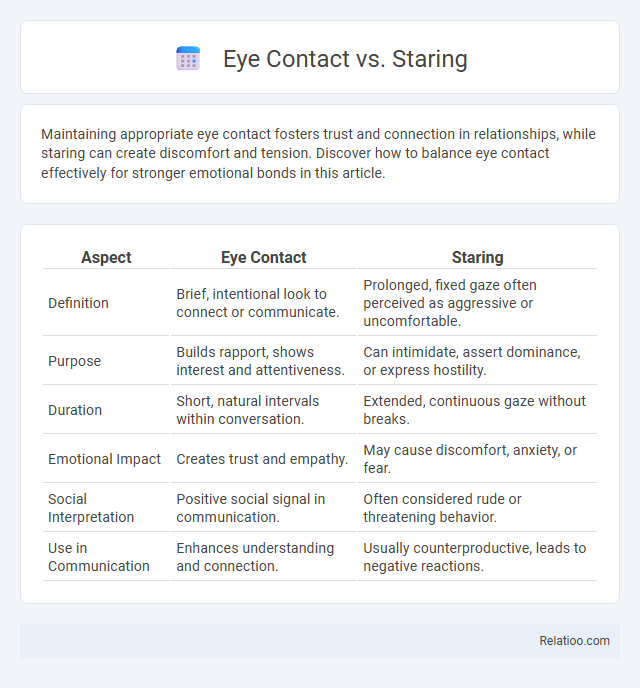Maintaining appropriate eye contact fosters trust and connection in relationships, while staring can create discomfort and tension. Discover how to balance eye contact effectively for stronger emotional bonds in this article.
Table of Comparison
| Aspect | Eye Contact | Staring |
|---|---|---|
| Definition | Brief, intentional look to connect or communicate. | Prolonged, fixed gaze often perceived as aggressive or uncomfortable. |
| Purpose | Builds rapport, shows interest and attentiveness. | Can intimidate, assert dominance, or express hostility. |
| Duration | Short, natural intervals within conversation. | Extended, continuous gaze without breaks. |
| Emotional Impact | Creates trust and empathy. | May cause discomfort, anxiety, or fear. |
| Social Interpretation | Positive social signal in communication. | Often considered rude or threatening behavior. |
| Use in Communication | Enhances understanding and connection. | Usually counterproductive, leads to negative reactions. |
Understanding Eye Contact: Definition and Importance
Eye contact involves briefly meeting another person's gaze to convey attention and engagement, while staring refers to prolonged, intense looking that can make others uncomfortable. Understanding eye contact is crucial for effective communication as it fosters trust, signals confidence, and helps interpret emotions accurately. Mastering your eye contact balance enhances social interactions and builds stronger relationships.
What Constitutes Staring? Key Differences
Staring is characterized by an unwavering, prolonged gaze that often feels intrusive or uncomfortable, differing from eye contact, which is typically brief and intentional, fostering connection and communication. Eye contact involves mutual engagement with periodic blinking and shifts in gaze, signaling attentiveness and respect. The key difference lies in the duration and intention: staring lacks the natural breaks and mutual consent of eye contact, often signaling aggression, curiosity, or discomfort rather than social connection.
Cultural Perspectives on Eye Contact and Staring
Cultural perspectives on eye contact and staring vary widely, influencing social interactions and communication styles across different societies. In many Western cultures, maintaining eye contact signals confidence and trustworthiness, while prolonged staring can be perceived as aggressive or intrusive. Your awareness of these cultural nuances enhances effective communication and helps avoid misunderstandings in diverse interpersonal settings.
Psychological Effects of Eye Contact
Eye contact fosters trust, emotional connection, and effective communication by activating the brain's social and empathetic centers, promoting a sense of safety and understanding. Staring, however, can trigger discomfort, anxiety, or perceived aggression due to prolonged intensity and violation of personal boundaries, leading to heightened stress responses in the amygdala. Balanced eye contact engages attentional networks and emotional regulation systems, enhancing interpersonal rapport and reducing social tension.
When Does Eye Contact Become Uncomfortable?
Eye contact becomes uncomfortable when it turns into staring, which feels intrusive and can create social tension by invading personal boundaries. Maintaining appropriate eye contact involves balanced focus that conveys attention and confidence without making Your interaction feel aggressive or intimidating. Recognizing subtle cues like blinking rates and facial expressions helps distinguish between engaging eye contact and discomfort-provoking staring.
Social Etiquette: Eye Contact vs Staring
Maintaining appropriate eye contact in social interactions signals attentiveness and confidence, fostering positive communication and connection. Staring, characterized by prolonged and intense gaze without breaks, can create discomfort, perceived as intrusive or aggressive behavior. Social etiquette emphasizes balanced eye contact that respects personal boundaries, allowing engagement without causing unease or intimidation.
Body Language Cues Accompanying Eye Contact
Eye contact, distinct from staring, involves maintaining a comfortable gaze that signals attentiveness and confidence without causing discomfort or intimidation, while staring often implies aggression or intrusion. Body language cues accompanying eye contact include relaxed facial expressions, nodding, and slight head tilts that reinforce engagement and understanding. Your ability to interpret these subtle signals enhances communication by fostering trust and connection in social or professional interactions.
Benefits of Positive Eye Contact in Communication
Positive eye contact enhances communication by building trust, conveying confidence, and fostering connection between individuals. Maintaining appropriate eye contact signals attentiveness and respect, which encourages open and effective dialogue. Your ability to balance eye contact without staring ensures comfort while promoting genuine engagement during conversations.
Consequences of Prolonged or Intense Staring
Prolonged or intense staring can cause discomfort, anxiety, and even perceived aggression, unlike natural eye contact which fosters trust and connection in communication. Your gaze held too long may lead others to feel threatened or uneasy, disrupting social interactions and reducing positive rapport. Maintaining balanced eye contact helps convey confidence and empathy without triggering negative emotional responses.
Tips for Maintaining Appropriate Eye Contact
Maintaining appropriate eye contact involves balancing direct focus without crossing into staring, ensuring your gaze conveys confidence and engagement. You can achieve this by briefly looking away every few seconds to avoid discomfort while sustaining genuine interest in the conversation. Practicing the 50/70 rule--holding eye contact 50% of the time while speaking and 70% while listening--helps optimize your nonverbal communication effectively.

Infographic: Eye contact vs Staring
 relatioo.com
relatioo.com